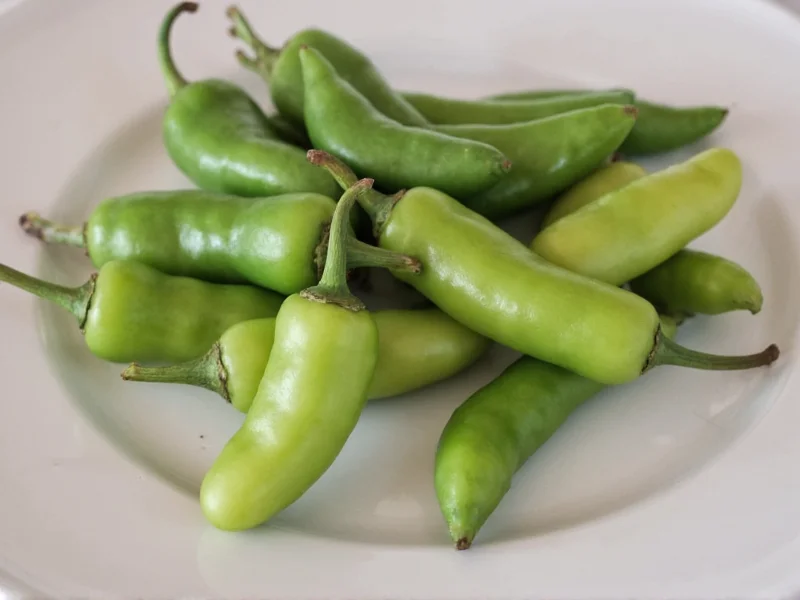The guero pepper, also known as aji guero or Peruvian guero, is a medium-heat chili pepper (5,000-30,000 Scoville Heat Units) originating from South America. This vibrant yellow-orange pepper features a distinctive fruity, citrusy flavor with moderate heat, making it versatile for salsas, ceviche, and marinades. Unlike jalapeños or serranos, guero peppers offer a unique flavor profile that balances brightness with manageable heat, appealing to both spice enthusiasts and casual cooks.
Understanding the guero pepper begins with recognizing its botanical identity and culinary significance. This Capsicum baccatum variety stands apart from more common peppers with its distinctive characteristics that have made it a staple in Peruvian and broader South American cuisine for centuries. While often confused with other medium-heat peppers, the guero maintains its unique position in the chili pepper family due to specific growing conditions and flavor development.
Physical Characteristics of Guero Peppers
Guero peppers typically measure 2-4 inches in length with a slender, tapered shape that narrows to a pointed tip. When immature, they appear bright green, gradually transforming through yellow stages to a vibrant orange or deep golden hue as they fully ripen. The thin skin texture allows for easy incorporation into raw preparations without overwhelming other ingredients. Unlike thicker-walled peppers like bell peppers, gueros maintain structural integrity during cooking while still releasing their distinctive flavors.
Heat Level and Scoville Rating Analysis
The guero pepper registers between 5,000 and 30,000 Scoville Heat Units (SHU), placing it firmly in the medium-heat category. This heat range makes it significantly milder than habaneros (100,000-350,000 SHU) but noticeably hotter than poblano peppers (1,000-2,000 SHU). What distinguishes guero from other medium-heat peppers is how its capsaicin distributes—providing a gradual warmth that builds slowly rather than an immediate intense burn.
| Pepper Variety | Scoville Heat Units | Heat Comparison |
|---|---|---|
| Guero Pepper | 5,000-30,000 | Moderate, building warmth |
| Jalapeño | 2,500-8,000 | Immediate, sharp heat |
| Serrano | 10,000-23,000 | Intense, upfront heat |
| Habanero | 100,000-350,000 | Extreme, lingering burn |
Flavor Profile and Culinary Applications
What truly sets the guero pepper apart is its complex flavor profile that extends far beyond mere heat. These peppers deliver bright citrus notes reminiscent of lemon and tropical fruit, with subtle earthy undertones. This distinctive combination makes guero peppers particularly valuable in raw applications where their nuanced flavors can shine without being altered by cooking.
Chefs specializing in South American cuisine frequently incorporate guero peppers into:
- Traditional Peruvian ceviche preparations
- Fresh salsas and pico de gallo variations
- Marinades for poultry and seafood
- Vinegar-based hot sauces
- Stir-fries where moderate heat is desired
Unlike many hotter peppers that primarily contribute heat, guero peppers function as both seasoning and flavor component, enhancing dishes with their aromatic qualities while providing balanced warmth.
Guero Pepper vs. Similar Varieties
Many home cooks confuse guero peppers with other medium-heat varieties, but key differences exist:
- Guero vs. Serrano: While both register in similar heat ranges, serranos deliver sharper, more immediate heat with grassier notes, whereas gueros offer fruitier flavors with more gradual warmth.
- Guero vs. Jalapeño: Jalapeños typically run milder with earthier flavors, while gueros provide brighter citrus notes and slightly more heat potential.
- Guero vs. Aji Amarillo: Though both are South American peppers, aji amarillo tends to be significantly hotter (30,000-50,000 SHU) with more pronounced floral notes.
Availability and Substitution Options
Finding fresh guero peppers can prove challenging outside specialty markets or regions with strong South American culinary influence. When unavailable, suitable substitutions include:
- Combining serrano peppers with a touch of lemon zest to mimic guero's citrus notes
- Using slightly underripe aji amarillo peppers with reduced quantity
- Blending jalapeños with a small amount of habanero for complexity
Dried guero peppers remain extremely rare, as their thin walls and high moisture content make them unsuitable for traditional drying methods. Fresh or frozen preparations represent the optimal way to experience authentic guero pepper characteristics.
Growing Guero Peppers at Home
Gardeners interested in cultivating guero peppers should note their specific requirements. These plants thrive in warm climates with consistent moisture and well-draining soil. Starting seeds indoors 8-10 weeks before the last frost date yields best results, with plants requiring 70-90 days to reach maturity. Unlike some chili varieties, guero peppers benefit from partial shade in extremely hot climates to prevent sunscald on developing fruit.
Nutritional Benefits of Guero Peppers
Like other chili peppers, gueros contain capsaicin and significant vitamin C content. A single guero pepper provides approximately 100% of the recommended daily vitamin C intake while contributing minimal calories. The capsaicin content may support metabolic health and provide anti-inflammatory benefits, though research specifically on guero peppers remains limited compared to more widely studied varieties.
Preserving Guero Pepper Flavor
To maintain the distinctive flavor profile of guero peppers, proper storage techniques prove essential. Refrigeration in perforated plastic bags extends freshness for 1-2 weeks. For longer preservation, consider:
- Quick-pickling in vinegar with citrus elements
- Freezing whole peppers for sauce applications
- Creating fresh hot sauces that capture peak flavor
Avoid traditional drying methods, as these significantly alter the delicate flavor balance that makes guero peppers distinctive.











 浙公网安备
33010002000092号
浙公网安备
33010002000092号 浙B2-20120091-4
浙B2-20120091-4